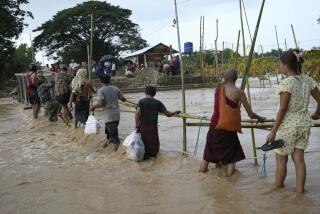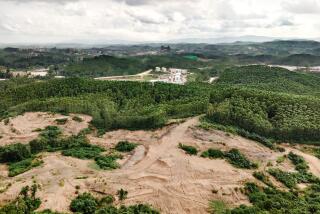Endless Trial for Tsunami Victims
KATUGODA, Sri Lanka ‚ÄĒ Sitting in the tattered tent that has been his home for the last eight months, Pela Ketiyage Sanjaya Premanath waves the flies away as he grips the cheaply framed photograph of his wife and reflects on what might have been.
Chandrika would be alive today, the 27-year-old widower says, if she had just ignored a mother’s natural instinct and run away from the gargantuan wave. Instead, she headed toward the sea to save her child, not knowing Pela Ketiyage had already taken the infant to higher ground.
It’s been a year since the deadliest tsunami in living memory killed an estimated 220,000 people, and here in southern Sri Lanka, life has moved on. From Pela Ketiyage’s vantage point, however, it hasn’t moved all that far.
Pela Ketiyage’s life underscores the plight of survivors faced with the frustratingly slow pace of reconstruction, the pain that lingers from Africa’s east coast to the Indonesian island of Sumatra, and the enormous human toll of those few fateful minutes on the morning of Dec. 26, 2004.
After the water demolished Pela Ketiyage’s house, killing six family members, the eight survivors headed for the nearby Sugatharama Buddhist temple, where they spent several weeks with hundreds of other refugees. Eventually, however, the head monk started losing patience with people smoking and drinking on hallowed grounds. So the family moved in with friends, until they wore out that welcome too.
Today they live in a 10-foot-square tent here in Katugoda, southeast of Galle, pitched between the coastal road and the remains of a grocery store, now their kitchen. Recently they’ve come under pressure from the owner to leave that site as well.
Throughout the tsunami zone, the lack of permanent housing remains a major problem, as does graft, confusion and incompetence surrounding the spending of billions of dollars on reconstruction. Months ago, a government official promised Pela Ketiyage and his family a place to live and asked them to fill out some forms. But because they’re not living in an official camp, they’ve fallen through most of the cracks instead of receiving aid.
When it rains, their beds get wet. When the wind blows in from the sea, their tent collapses, forcing them to reassemble the stakes, wedge the Styrofoam blocks back in place and reposition the blue plastic tarps.
Most of the few belongings were scrounged in the tsunami’s immediate aftermath, they say, pointing to the stained plastic chairs repaired with bits of copper wire. They found a metal shelf to hold dishes. And their closet is a pile of cardboard boxes just inside the tent flaps. They found some of their own mud-stained shirts a few blocks inland, a source of comfort.
It’s late morning, but two of Pela Ketiyage’s younger brothers are still sleeping on the makeshift mattresses that cover the tent’s floor. There aren’t enough mosquito nets, so family members make up for the fitful nights by napping during the day.
They don’t have much money, but graciously offer visitors tea. When they recovered Chandrika’s body, her jewelry was gone, taken by thieves. The wave swallowed Pela Ketiyage’s tools and with it his livelihood as a diesel mechanic. His father had been a skipper on a fishing boat. With so many boats destroyed, he only lands the occasional crew job now. If the fish are biting, he makes $10 for several days’ work, the family’s only income.
Their only light at night is from a single kerosene lamp, its protective glass gone, so it goes out when it’s windy. Living beside the road means someone has to watch Pela Ketiyage’s 21-month-old son, who likes to run into the road. The older children play cricket on the beach around the rubble, using a makeshift bat and ball. With so little light, the family typically sits by the road after dark and watches the aid-filled trucks go elsewhere.
Sometimes Pela Ketiyage and his family think about how this happened. Some neighbors attribute the tsunami to God’s wrath. But his mother, Sebba Kuttige Priyangani, 44, questions that logic. If that were so, she says, why did so many innocent children lose their lives? The family also wonders at the randomness of it all, why Pela Ketiyage’s wife died, still young and strong, whereas his mother survived after being swept out to sea and back. She points to the top of a telephone pole, her inanimate hero.
Recovery efforts go through stages, and the tsunami aftermath is no exception. With most emergency food and basic health needs met, housing has become the main priority. Sri Lankan government officials initially promised to have 60% of permanent houses built within a year and 100% by 2007.
That estimate has proved wildly optimistic. Less than 10% of the permanent houses are ready, as Pela Ketiyage’s growing frustration attests. More than 100,000 people in Sri Lanka and 300,000 in Aceh, Indonesia, are still displaced from their homes.
All told, 12 nations were hit by the tsunami that followed a wrenching magnitude 9 earthquake off the coast of Aceh. About 223,000 people were killed, according to the United Nations, although the exact number may never be known given that many bodies washed out to sea and population figures in the affected areas were not always reliable. In Indonesia and Sri Lanka, the worst hit, entire communities were washed away. Thailand’s tourist industry was hit hard, and parts of the Maldives were temporarily submerged.
The U.N. estimates that 2 million people were left homeless after the series of waves destroyed nearly 400,000 houses. Global aid pledges reached $13.6 billion. But the actual amount delivered has been lower, as often happens, and the British aid agency Oxfam estimates that only 20% of those displaced are in permanent housing.
A mammoth disaster has also meant mammoth confusion. The waves of money and legions of aid workers, dubbed by some as the second tsunami, have often been too much for the region to absorb. Some quietly say there’s too much money to spend effectively, given the limitations on the ground.
Sri Lanka’s highly centralized bureaucracy has at times nearly ground to a halt, creating bottlenecks. Scores of registered charity groups and untold thousands of unregistered aid workers often toil at cross-purposes.
‚ÄúWe‚Äôre trying to avoid having two groups show up and build toilets in the same place, while elsewhere there are none at all,‚ÄĚ said Cynthia Marie Caron, a consultant with the U.N. Office for the Coordination of Humanitarian Affairs, surrounded by thick binders and multicolored maps. ‚ÄúThe numbers often don‚Äôt add up because it‚Äôs largely based on self-reporting.‚ÄĚ
Medicines arrived expired or without labels, only to be thrown away. Donations of winter clothes were no help in this tropical country. Buddhist humanitarians balked at building houses for Muslims and vice versa. Locals often weren‚Äôt consulted, resulting in new houses built in flood zones, without drinking water, far from transport. A badly enforced government proposal to keep the coast free of buildings delayed construction, even as some suspected that the ‚Äúsafety proposal‚ÄĚ was a really a land grab.
‚ÄúThey never asked our opinion,‚ÄĚ said K.R. Rathnasiri, 33, who has lived with several family members in a tiny temporary house for the last nine months. ‚ÄúNo one ever checked out what we want.‚ÄĚ
In another mismatch, some well-intentioned donors have modeled everything on their own country, without necessarily taking into account local social structures. The Salzburg Village near Galle, built by Austrian donors, resembles a town in the Alps. Fishermen welcome the largess but say they’re miles from the sea, unable to guard their boats at night or get to work in the morning.
Some have benefited more than others. In Salzburg Village, where homes bear plaques such as ‚ÄúStiegl Brewery of Salzburg‚ÄĚ and ‚ÄúAustrian Labor Union,‚ÄĚ residents say seven members of one family, including a husband and wife, each got their own house, whereas thousands elsewhere are still without.
The northern and eastern shores of Sri Lanka, some of the hardest hit, have received far less aid than the south, stronghold of the majority Sinhalese. In Hambantota, the home district of the president, plans call for building 2,253 houses, although only 1,158 lost their homes, says Danny Lee, representative with the Tzu Chi Foundation of Taiwan, which recently scaled back its construction plans.
There have been the inevitable corruption charges, particularly surrounding Sri Lanka‚Äôs presidential election in November. ‚ÄúThere‚Äôs been huge bungling and misallocation of funds,‚ÄĚ added Fredrica Jansz, a reporter with the Sunday Leader newspaper, which published an expose on the questionable use of tsunami funds in bank accounts linked to President Mahinda Rajapakse.
‚ÄúPeople not even affected by the tsunami are receiving aid just because they know someone,‚ÄĚ said Anushika Amarasinghe, a Transparency International program director based in Colombo, the Sri Lankan capital.
In the isolated village of Sindujayapura on the southeastern coast, fishermen who lost their boats line up to clean a reservoir twice a week for $6 under an Oxfam work-for-cash program. They welcome the subsistence help, their only income, but say the real problem is local government agents who play favorites.
‚ÄúThey only give boats and nets to family members, friends or those who pay bribes,‚ÄĚ said Wijesuriya Patabendige, 42. ‚ÄúThere‚Äôs a complaint office, but it‚Äôs staffed by the same people asking for bribes. We want our livelihoods back.‚ÄĚ
Others worry about another unintended consequence from the well-intentioned wash of aid. ‚ÄúI think we‚Äôre creating a begging culture,‚ÄĚ said Palitha Abeykoon, a consultant with the World Health Organization. ‚ÄúEverything is free, people come for breakfast, lunch, take a nap, all at the camps, then get a $5 handout. It‚Äôs no good, like giving a hungry man a bottle of whisky.‚ÄĚ
Although tsunami-wrecked buildings, destroyed boat hulls and upended buses still dot the landscape, there has been huge progress as well. The construction industry is working overtime building houses and shops. Companies are hiring again, and people are slowly remaking their lives, with or without sufficient support. ‚ÄúSince the tsunami, we‚Äôve been praying for a boat and a house,‚ÄĚ Sebba Kuttige, Pela Ketiyage‚Äôs mother, said. ‚ÄúSo far it‚Äôs not coming, but we‚Äôll wait. We must have faith.‚ÄĚ
Dinda Jouhana in The Times’ Jakarta Bureau contributed to this report.
*
(Begin Text of Infobox)
One year later
The toll of dead and missing from last year’s Indian Ocean tsunami is at least 216,858, according to government and aid agency figures.
*--* Country Dead Missing Indonesia 131,338 25,016 Sri Lanka 31,229 4,093 India 10,749 5,640 Thailand 5,395 2,817 Somalia 289 -- Myanmar 90 10 Maldives 82 26 Malaysia 68 -- Tanzania 11 -- Bangladesh 2 -- Seychelles 2 -- Kenya 1 --
*--*
Note: The United Nations said last week its total of dead and missing was 223,492, but it noted that some figures were still being updated and that some countries did not distinguish between those killed and those missing.
*
Sources: Indonesian Red Cross; Sri Lanka government’s tsunami task force; aid agency tallies for Myanmar and Somalia completed in the months immediately after the tsunami but not recently updated; Associated Press
More to Read
Sign up for Essential California
The most important California stories and recommendations in your inbox every morning.
You may occasionally receive promotional content from the Los Angeles Times.










